The ASUS Z170-A Motherboard Review: The $165 Focal Point
by Ian Cutress on October 20, 2015 2:00 PM EST- Posted in
- Motherboards
- Asus
- ATX
- Skylake
- Z170
Gaming Performance 2015
Our 2015 gaming results are still relatively new, but the issue of FCLK settings might play a big role here. At launch, the default setting for the communication buffer between the CPU and PCIe stack was 800 MHz, even though Intel suggested 1000 MHz, but this was because of firmware limitations from Intel. Since then, there is firmware to enable 1000 MHz, and most motherboard manufacturers have this - but it is unclear if the motherboard will default to 1000 MHz and it might vary from BIOS version to BIOS version. As we test at default settings, our numbers are only ever snapshots in time, but it leads to some interesting differences in discrete GPU performance.
Alien: Isolation
If first person survival mixed with horror is your sort of thing, then Alien: Isolation, based off of the Alien franchise, should be an interesting title. Developed by The Creative Assembly and released in October 2014, Alien: Isolation has won numerous awards from Game Of The Year to several top 10s/25s and Best Horror titles, ratcheting up over a million sales by February 2015. Alien: Isolation uses a custom built engine which includes dynamic sound effects and should be fully multi-core enabled.
For low end graphics, we test at 720p with Ultra settings, whereas for mid and high range graphics we bump this up to 1080p, taking the average frame rate as our marker with a scripted version of the built-in benchmark.
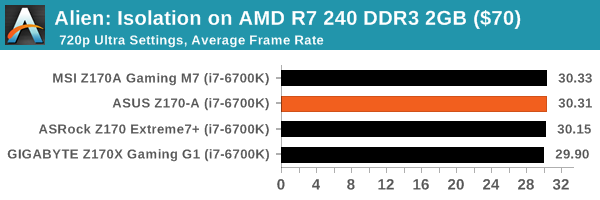
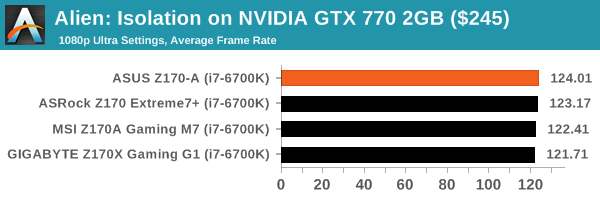
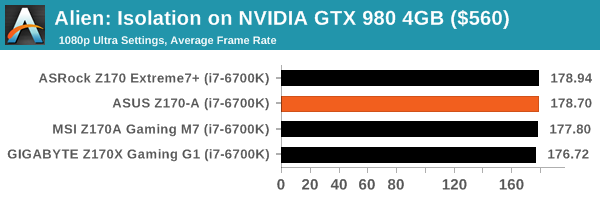
Total War: Attila
The Total War franchise moves on to Attila, another The Creative Assembly development, and is a stand-alone strategy title set in 395AD where the main story line lets the gamer take control of the leader of the Huns in order to conquer parts of the world. Graphically the game can render hundreds/thousands of units on screen at once, all with their individual actions and can put some of the big cards to task.
For low end graphics, we test at 720p with performance settings, recording the average frame rate. With mid and high range graphics, we test at 1080p with the quality setting. In both circumstances, unlimited video memory is enabled and the in-game scripted benchmark is used.
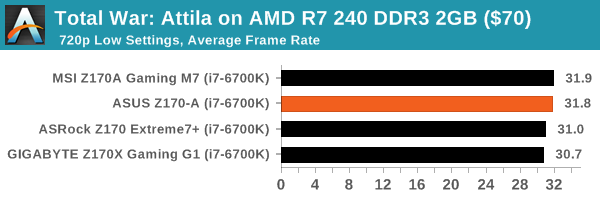

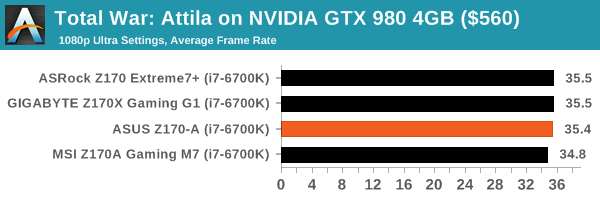
Grand Theft Auto V
The highly anticipated iteration of the Grand Theft Auto franchise finally hit the shelves on April 14th 2015, with both AMD and NVIDIA in tow to help optimize the title. GTA doesn’t provide graphical presets, but opens up the options to users and extends the boundaries by pushing even the hardest systems to the limit using Rockstar’s Advanced Game Engine. Whether the user is flying high in the mountains with long draw distances or dealing with assorted trash in the city, when cranked up to maximum it creates stunning visuals but hard work for both the CPU and the GPU.
For our test we have scripted a version of the in-game benchmark, relying only on the final part which combines a flight scene along with an in-city drive-by followed by a tanker explosion. For low end systems we test at 720p on the lowest settings, whereas mid and high end graphics play at 1080p with very high settings across the board. We record both the average frame rate and the percentage of frames under 60 FPS (16.6ms).
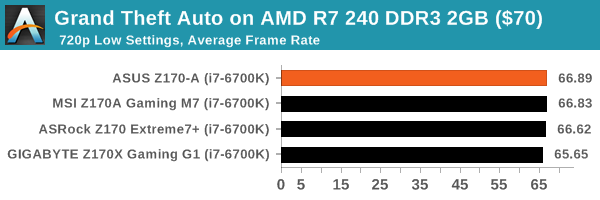

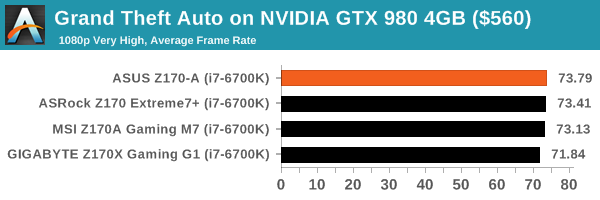
GRID: Autosport
No graphics tests are complete without some input from Codemasters and the EGO engine, which means for this round of testing we point towards GRID: Autosport, the next iteration in the GRID and racing genre. As with our previous racing testing, each update to the engine aims to add in effects, reflections, detail and realism, with Codemasters making ‘authenticity’ a main focal point for this version.
GRID’s benchmark mode is very flexible, and as a result we created a test race using a shortened version of the Red Bull Ring with twelve cars doing two laps. The car is focus starts last and is quite fast, but usually finishes second or third. For low end graphics we test at 1080p medium settings, whereas mid and high end graphics get the full 1080p maximum. Both the average and minimum frame rates are recorded.
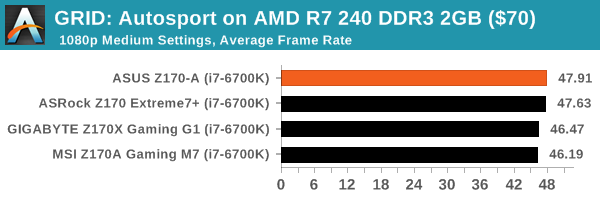

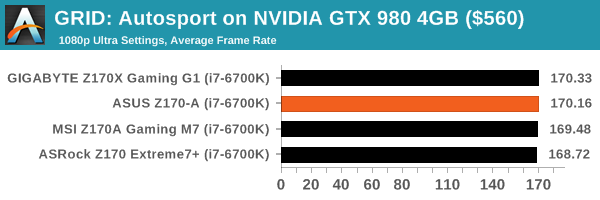
Middle-Earth: Shadows of Mordor
The final title in our testing is another battle of system performance with the open world action-adventure title, Shadows of Mordor. Produced by Monolith using the LithTech Jupiter EX engine and numerous detail add-ons, SoM goes for detail and complexity to a large extent, despite having to be cut down from the original plans. The main story itself was written by the same writer as Red Dead Redemption, and it received Zero Punctuation’s Game of The Year in 2014.
For testing purposes, SoM gives a dynamic screen resolution setting, allowing us to render at high resolutions that are then scaled down to the monitor. As a result, we get several tests using the in-game benchmark. For low end graphics we examine at 720p with low settings, whereas mid and high end graphics get 1080p Ultra. The top graphics test is also redone at 3840x2160, also with Ultra settings, and we also test two cards at 4K where possible.
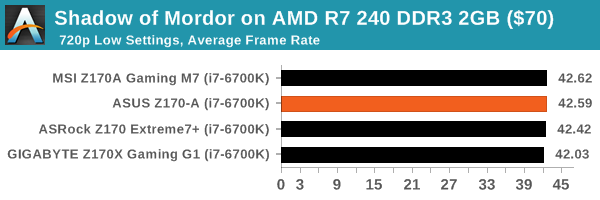
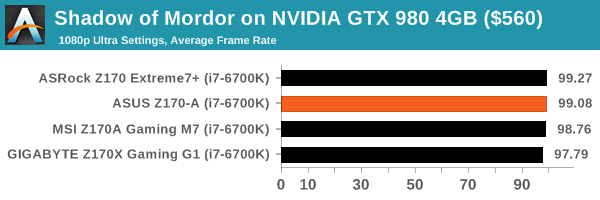
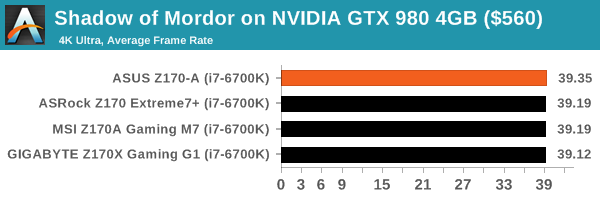
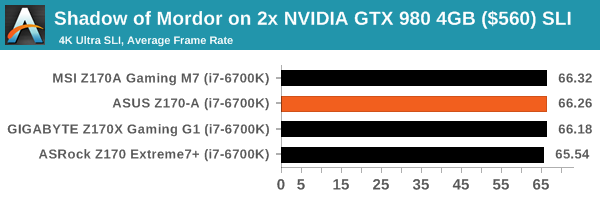















29 Comments
View All Comments
Le Geek - Wednesday, October 21, 2015 - link
I believe you meant "front" USB 3.1 panel instead of "font" in the conclusion.AlexIsAlex - Thursday, October 22, 2015 - link
"Non UEFI POST Time": Could you clarify this a bit - do you mean if not booting using UEFI? If so, then why not? These days, I would have thought UEFI booting would be the more common case.The major delay I'm seeing booting with this board is between power-on and first text-on-screen. Not sure exactly what it's doing there, but it's a good few seconds of black before getting the info screen (or graphical logo, depending on configuration)
Arbie - Sunday, October 25, 2015 - link
It's amazing what a high-tech assembly of high-tech parts we can buy for $165.Anyway - please don't forget to credit Asus for their attention to fan control. I haven't checked the competition this time around but in the past Asus has been way, way ahead. This is one mobo function that reviewers *constantly* overlook and thereby undervalue, since they aren't building in a box. So Asus, who goes the extra mile and beyond, is rarely credited for doing so.
ymmv__ - Monday, October 26, 2015 - link
I wish Anand Tech would use an editor to streamline Ian Cuttress' convoluted, badly written texts. This stuff is nigh unreadable.gw74 - Tuesday, October 27, 2015 - link
Sabertooth Z170 Mark 1 thoablevy - Tuesday, October 27, 2015 - link
Just finished a build with this board. For storage I used a Samsung 850 EVO SSD.for the operating system and a WD 1T hard drive. I loaded Wind 7 back on and updated to Win 10 with no problem. Loaded most of my wifes software and then it crashed. It crashed so hard I couldn't get to the BIOS! I finally found that by unplugging the SSD I could get into the BIOS. I turned the machine off and booted Into the BIOS. I noticed that the SSD was listed on the sata ports but not in the boot list. However if I went to the boot menu, the samsung drive was listed and I could boot to it. I tried a number of fixes including resetting the CMOS, updating the BIOS, reinstalling WIn 10, moving the SSD to another SATA port. No joy. Finally I spent some time on Google and found that others have run into this on previous ASUS MBs. I finally found that one of the people found that if you powered off and disconnected the power for 10-15 minutes the computer boots to the SSD. I have rebooted 3-4 times now with no problem. It's worth noting that the Samsung still doesn't show up in the boot list. Note also that I had a chat with a tech from Asus and while he made some suggestions about what to try, he was not aware of this fix. Maybe this post will get Asus to look into this issue and fix their bios.ghanz - Saturday, October 31, 2015 - link
Try enabling Sata hot plug in the bios.And when you manage to boot into windows, disable Intel RST link power management.
Some SSDs have compatibility issues on certain platforms & configurations if power saving options are enabled.
ablevy - Monday, November 2, 2015 - link
After loading a new bios, the SSD showed up on the advanced page as one of the drives in the boot list and I could move it to the top. Since then no problems with booting from the SSD.Thanks
ablevy - Saturday, November 7, 2015 - link
I spent some time exploring overclocking and found that the latest UEFI is buggy. For example trying to return to default fails under all conditions I have tried, including shorting the CMOS as Asus recommends or removing the battery. Exiting from the UEFI sets Autotune on even when you exit from the "default" and you end up in the "optimized default". A second issue I had with this board is "black screens" when the system is idle which don't respond to the keyboard or mouse. I finally noticed that the keyboard was actually off and realized tha the power option to selectively turn off the USB ports was selected. Turning off this option solved part of the "Black Screen" problem. However I still suffered from occaisonal "black screens". I have now turned off all power options and for about the last 24 hours of constant operation haven't had any "black screens". My recommendation for anyone building this system is to install Win 7 and wait a few months before installing Win 10. In my opinion the UEFI is not ready for prime time.ablevy - Wednesday, November 18, 2015 - link
I have continued to work with the machine and the "black screen" issue has not reappeared. However a new stability problem has appeared. Under some circumstances the USB ports fail to recognize the Apple iPhone. I have not isolated why, but the resulting symptoms are very reproducible. First plugging the iphone into the computer does not result in a connection to the iphone. Second turning the computer off results in the screen and apparently Windows shutting down, but the power light doesn't shut off. There also seems to be intermittent disk action given that the disk light blinks. After a few minutes I shut the computer down by holding the power down. Restarting the computer leads to a long boot time before the Windows logo comes up, but Win 10 boots normally. However the iphone will not connect either through a USB 3.0 port or a 2.0 port. Windows will also not see a memory stick in either port. Turning the machine off results in the same behavior. Power light remains on, until held down for 8-10 seconds. If however you turn the power off at the power supply and leave it off for somewhere between 5 (less than 5 min won't work)) and 15 minutes then turn the power supply back on and reboot the computer will boot normally (relatively short boot time) and again recognizes the iphone. This behavior of requiring a power off is reminiscent of the original boot problem I had in which I had to turn off the power supply for the computer to see my SSD and boot from it. My best guess is that in addition to the problem Asus has with the USB ports that cause this issue there is a problem with the shutdown cycle and things are being saved that shouldn't be.Note that I'm currently using BIOS 1302 and that the previous BIOS version also exhibited the same issue.
This is a copy of the email I sent Asus today. I am still having difficulty recommending this mb based on the bios issues.